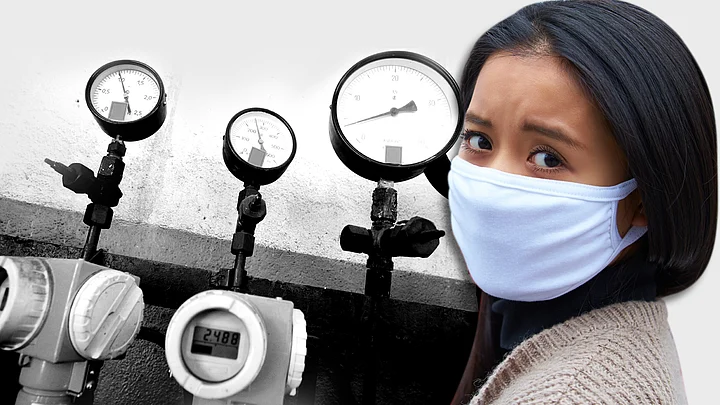One of the biggest spinoffs of the 15-day number plate experiment in the capital is that it has made people aware of air pollution.
As the adage goes, ‘if you can’t measure it, you can’t manage it.’ However, the information has to be standardised and made available in real-time, rather, like temperatures.
The media is already publishing continuous data for some cities daily from the US embassy and SAFAR – System of Air Quality and Forecasting and Research – from the Pune-based Indian Institute of Tropical Meteorology.
The latter is available for air quality in six cities – Delhi, Ahmedabad, Pune, Mumbai, Chennai and Kolkata – in real-time and carries forecasts for the following three days.
Gauging Air Quality
In October 2014, India adopted international practice by colour-coding urban air quality – green for good, yellow for moderate, orange for poor, and red for worse. This is called the Air Quality Index (AQI), comprising key pollutants.
At a recent meet in Bangalore of the Indian Society of Ecological Economists, Sarath Guttikunda, Director of the independent research group UrbanEmissions.Info, outlined how speedy and reliable information was key to solving air pollution in our cities.
Planners need to know the extent of pollution of various contaminants, their location and source of pollutants.
Some Futile Efforts
As an example of what shouldn’t be done, a giant vacuum cleaner costing Rs 2.5 crores was installed at Connaught Place in 2010 under the mistaken impression that it would suck out the pollutants in this city centre.
This cost was equivalent to setting up of two monitoring stations, which alone could provide real-time information.
Beijing, which has roughly the same number of people as New Delhi, though with a far lower density, has 35 such stations, as compared to only 11 in the capital.
The pollutants that need to be tracked are particulate matter below 10 microns in diameter or PM₁₀, smaller PM2.5, sulphur dioxide or SO₂, nitrogen dioxide or NO₂, ozone and carbon monoxide or CO.
In many countries in the global North and Australia, the media informs the public of ozone levels because excessive amounts can cause skin cancers. These, typically, only affect white-skinned people.
Providing Pollution-Related Data
- Currently, obtaining information is hamstrung by the fact that there are 450 monitoring stations which collect data manually.
- Instead of getting discontinuous information for ten pollutants, it will be more effective to get data on one pollutant like PM2.5, at ten locations.
- A simple solution is to collate the Pollution Under Check (PUC) data, which is available every three months which can reveal the age of vehicle.
- Gathering data shouldn’t be restricted to vehicular pollution alone, for instance, standards are now being established for pollution from coal-fired thermal power stations.
Air Pollution, the Killer
In this country, sources – which vary from city to city include power plants, industries, construction, road dust, burning garbage, domestic fuels and vehicle exhausts.
According to a World Health Organisation (WHO) global burden of disease study in 2010, there were as many as 6,27,000 premature deaths in India due to outdoor air pollution, of which 1,00,000 can be attributed to residential (indoor) fuel combustion contributing to outdoor pollution.
In Asia, air pollution was the sixth biggest cause of preventable deaths, accounting for 3.1 million deaths.
Since the WHO has now listed Delhi the world’s most polluted city, and 13 out of the 20 worst cities are in India, it is self-evident that the biggest toll of health will be in this country.
A Health Ministry report this year (2016) has confirmed that vehicle emissions and pollutants cause asthma. But many citizens, particularly slum dwellers, may not be aware that respiratory diseases are caused by air pollution.
Monitoring Air Quality
Currently, obtaining information is hamstrung by the fact that there are 450 monitoring stations which collect data manually. In a week, from each station, one can only get three or four readings, not continuous data.
Instead of getting discontinuous information for ten pollutants, it will be more effective to get data on one pollutant like PM2.5, at ten locations.
For 30 continuous monitoring stations in 50 cities for ten operating years, it would cost Rs 7,500 crores, less than 1 per cent of the smart cities budget. Air pollution doesn’t even get a mention in this initiative.
There isn’t any time to lose in getting such data. In Delhi, it is estimated that 55 per cent of the population is exposed to daytime outdoor pollution.
There are a number of low-cost alternatives for individuals to get information, for example hand-held monitors like Dust-Traks for PM. With smartphones, it is now possible to monitor what are pollution levels in real time.
What is the Way-Out?
By knowing where the major traffic snarls are, it is possible to avoid the most congested junctions and thereby avoid exposure to pollution.
A simple solution is to collate the Pollution Under Check (PUC) data, which is available every three months. It can tell how old a vehicle is and how much it has been driven.
An elementary three-minute survey can also be conducted at petrol stations to collect data on types of vehicle, fuel, age and mileage.
Gathering data isn’t restricted to vehicular pollution but has nation-wide applications. For instance, standards are now being established for pollution from coal-fired thermal power stations.
Data can reveal the age of such plants, what fuel they use and their emissions. Once this is obtained, the authorities can decide what steps to take from a health perspective. These can also be compared with standards in China, a competing trading country.
Finally, since 800 million Indians use smoky cook stoves, it is possible to obtain census data on the type of devices, the type and amount of fuel, and so on.
Controlling such indoor pollution can dramatically improve people’s health – or more correctly, that of women and children – in the country.
(The author is a senior Mumbai-based journalist.)
